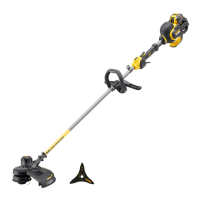7
English
SAVE THESE INSTRUCTIONS
Chargers
chargers require no adjustment and are designed
to be as easy as possible tooperate.
Important Safety Instructions for All
Battery Chargers
SAVE THESE INSTRUCTIONS: This manual contains
important safety and operating instructions for compatible
battery chargers (refer to TechnicalData).
• Before using charger, read all instructions and cautionary
markings on charger, battery pack, and product using
batterypack.
WARNING: Shock hazard. Do not allow any liquid to
get inside charger. Electric shock mayresult.
WARNING: We recommend the use of a residual
current device with a residual current rating of 30mA
orless.
CAUTION: Burn hazard. To reduce the risk of injury,
charge only
rechargeable batteries. Other
types of batteries may burst causing personal injury
anddamage.
CAUTION: Children should be supervised to ensure
that they do not play with theappliance.
NOTICE: Under certain conditions, with the charger
plugged into the power supply, the exposed charging
contacts inside the charger can be shorted by foreign
material. Foreign materials of a conductive nature
such as, but not limited to, steel wool, aluminum foil or
any buildup of metallic particles should be kept away
from charger cavities. Always unplug the charger from
the power supply when there is no battery pack in the
cavity. Unplug charger before attempting to clean
• DO NOT attempt to charge the battery pack with
any chargers other than the ones in this manual.
The charger and battery pack are specifically designed to
worktogether.
• These chargers are not intended for any uses other
than charging
rechargeable batteries.
Any other uses may result in risk of fire, electric shock
orelectrocution.
• Do not expose charger to rain orsnow.
• Pull by plug rather than cord when disconnecting
charger. This will reduce risk ofdamage to electric plug
andcord.
• Make sure that cord is located so that it will not be
stepped on, tripped over, or otherwise subjected to
damage orstress.
• Do not use an extension cord unless it is absolutely
necessary. Use of improper extension cord could result in
risk of fire,electric shock, orelectrocution.
Residual Risks
To ensure you have good footing on slopes, do not
overreach. Keep your balance at all times. Always walk, do
not run.
Additional residual risks may arise when using the tool
which may not be included in the enclosed safety warnings.
These risks can arise from misuse, prolonged use etc.
Even with the application of the relevant safety regulations
and the implementation of safety devices, certain residual
risks can not be avoided. These include:
• Injuries caused by touching any rotating/moving parts.
• Injuries caused when changing any parts, blades or
accessories.
• Injuries caused by prolonged use of a tool. When using any
tool for prolonged periods ensure you take regular breaks.
• Impairment of hearing.
• Health hazards caused by breathing dust developed when
using your tool (example: working with wood, especially
oak, beech and MDF.)
Electrical Safety
The electric motor has been designed for one voltage only.
Always check that the battery pack voltage corresponds
to the voltage on the rating plate. Also make sure that the
voltage of your charger corresponds to that of yourmains.
Your
charger is double insulated in
accordance with EN60335; therefore no earth wire
isrequired.
WARNING: 115 V units have to be operated via a
fail-safe isolating transformer with an earth screen
between the primary and secondary winding.
If the supply cord is damaged, it must be replaced by a
specially prepared cord available through the
serviceorganisation.
Mains Plug Replacement
(U.K. & Ireland Only)
If a new mains plug needs to be fitted:
• Safely dispose of the oldplug.
• Connect the brown lead to the live terminal in theplug.
• Connect the blue lead to the neutralterminal.
WARNING: No connection is to be made to the
earthterminal.
Follow the fitting instructions supplied with good quality
plugs. Recommended fuse: 3A.
Using an Extension Cable
An extension cord should not be used unless absolutely
necessary. Use an approved extension cable suitable for
the power input of your charger (see Technical Data). The
minimum conductor size is 1mm
2
; the maximum length
is30m.
When using a cable reel, always unwind the
cablecompletely.

